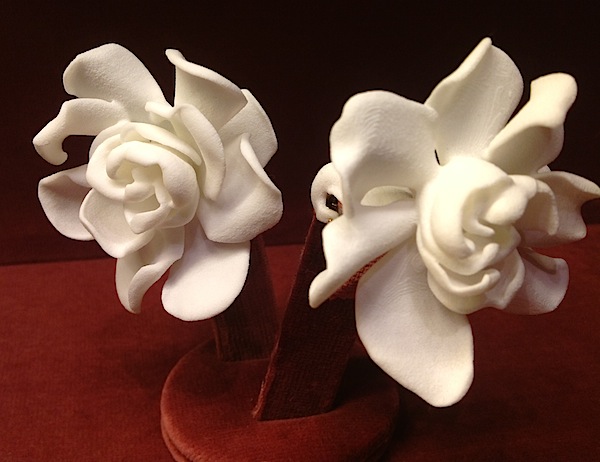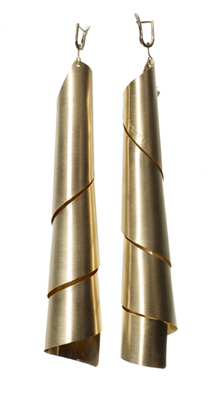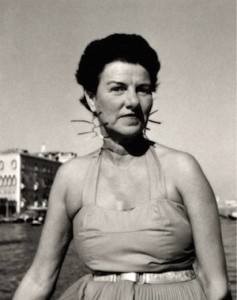A fun new coffeetable book on earrings just hit the stands, tracing our fascination with ear ornament from medieval times through the 20th century. I Love Those Earrings: A Popular History from Ancient to Modern was written by Jane Merrill and Chris Filstrup with contributions by jewelry aficionados such as Newark Museum curator Ulysses Grant Dietz, geological engineer Rafai Swiecki, and appraiser Antoinette Matlins. You’ll find this essay by me (reprinted here by permission) on pages 150-151.
DESIGNING OUTSIDE THE BOX
Earrings present a particular challenge when it comes to designing “outside the box.” Not only do they have to match, or at least correlate design-wise, they must also be relatively lightweight, if the designer expects them to be worn. Necklaces and bracelets hang from sturdy parts of the skeleton — the neck and wrist. Rings are supported by another, our fingers, and a brooch can be pinned to a lapel, but earrings dangle from fragile bits of flesh, our earlobes.

Much as we might like to dangle fabulous sculptures and chunky gemstones from our ears, there’s a weight limit for that delicate body part. As the Bible says, “the spirit is willing but the flesh is weak.”
If the earring attaches via piercing, as is most common these days, the hole in the flesh is going to be noticeably stretched unless a designer covers that with a button closure — adding even more weight to the proposition. If a heavy earring attaches via clip, that clip has to squeeze pretty tight to the earlobe to keep from sliding off under the weight. Ouch. No wonder celebs on the red carpet often forego “statement earrings” for the “statement necklace.”
I once interviewed an enamel artist who had become famous for his art jewelry. His enameling was breathtaking, wildly creative, perfectly crafted. But when he invited me to try on a pair of his enameled gold earrings at the Manhattan gallery that represented him, I thought they were going to rip my ears off. I couldn’t get them off fast enough. Yet women were lining up to buy. They were “collectible.” I never saw anyone actually wearing them.
Most famous sculptors and artists who try their hands at designing jewelry start (and often end) with a necklace, a ring, a brooch, or a bracelet — one-offs with relatively few design constraints. But a few brave souls go on to attempt the challenge of designing earrings, those twin sculptures that attach to the lobe and frame the face.
Alexander Calder, Salvador Dali, and Man Ray are a few of the creative visionaries who attempted – and beautifully managed – to reinvent the earring in the last century, the latter two with the help of skilled goldsmiths.
Bespoke designers such as Joel Arthur Rosenthal, known as JAR, have also designed mismatched and oversized earrings that sell for hundreds of thousands at auction.
 Other artists and designers have been less successful at creating eye-catching ear ornaments that were actually wearable by a human being with nerve endings, but who could blame them for trying? Earrings are one of the most noticeable pieces of jewelry anyone can wear. They’re the first ornament someone sees when they look at your face.
Other artists and designers have been less successful at creating eye-catching ear ornaments that were actually wearable by a human being with nerve endings, but who could blame them for trying? Earrings are one of the most noticeable pieces of jewelry anyone can wear. They’re the first ornament someone sees when they look at your face.
For this reason, women were keen to buy Man Ray’s famous gold spirals (pictured right). The French actress Catherine Deneuve was famously photographed with his giant sculptures hanging from her ears, no visible sign of pain on her beautiful face. The secret? Well, she was an actress! But also Man Ray – or, more likely, Gem Montebello, the Italian jeweler that actually created the earrings from the artist’s sketch – designed a hook that fit over the outside of the ear so the weight and bulk of the earring was supported by the ear itself – that is the cartilage, rather than the earlobe. You can’t see this hook behind Deneuve’s lustrous blonde mane.
Deneuve was neither the first nor the last to don Man Ray’s honking spirals. Joan Sonnabend had at least one pair in her Manhattan gallery, Sculpture to Wear, and was photographed wearing them – with a smile on her face, of course.
There were no such clever mechanisms behind the over-sized hammered brass jewelry Calder was making before World War II. Calder made dozens of smaller, more practical earrings as well, given that jewelry paid his bills as he built his reputation as a sculptor and fine artist. But let’s face it, those tiny hammered spirals weren’t going to get his wealthy patrons noticed.
When avant-garde collectors such as Mary Rockefeller and Peggy Guggenheim wore a Calder creation into a cocktail party, they expected heads to turn. Guggenheim claimed she was the only one willing to sacrifice her lobes to this quest. “Every woman in New York who is fortunate enough to be decorated by a Calder jewel has a brooch or a bracelet or a necklace,” she once wrote. “I am the only woman in the world who wears his enormous mobile earrings.”

The earrings she refers to were in the Calder Jewelry exhibition at the Philadelphia Museum of Art in 2008, and she wasn’t kidding when she said “enormous.” Made from hammered sterling, they measured six inches long and almost five inches wide. I didn’t lift them but I couldn’t imagine hanging them from my ears. However, Calder was famous for inventing the mobile and if you wanted a recognizable Calder, you wore mobiles-for-the-ears. It wouldn’t be the first time a woman put up with intense pain in order to turn heads.
Calder was influenced by African tribal art and jewelry, and certain tribes have been putting up with that kind of pain for centuries in order to ornament their bodies. In fact, many tribes purposely expanded the piercings in their earlobes until they could fit plugs measuring several inches across. Not too many of us are willing to go that far.
Regardless of the toll they may take on our lobes, however, shoulder-grazing earrings go in and out of style. Dramatically chunky danglers have been showing up again lately in runway shows and red carpet events.
There is an art to carving gems so they look substantial but don’t weigh a ton. As for precious metals, one way to minimize weight without sacrificing size is to build earrings around a hollow structure. Stanley Lechtzin perfected this technique, known as electroforming, in the late ’60s and early ’70s, which allowed for some highly-sophisticated goldsmithing around hollow, deceptively lightweight ornaments. His Torque series is a great example.
Filigree is a more time-tested way to increase size without increasing weight. Greek and Etruscan jewelers were making dramatic, intricate filigree earrings from gold wire as early as the 6th century B.C. Not only did this delicate, open metalwork mean they could make earrings bigger and more elaborate, they could do it with a relatively tiny amount of precious metal. When the cost of gold hit an all-time high in recent years — nearly $1,700 an ounce — the art of filigree made something of a comeback.
For fashion earrings, the sky’s the limit in terms of materials — and, therefore, so is size, shape and color. Aluminum and resin are lightweight enough to lend size and drama to earrings – evidenced by the large feather and floral earrings JAR designed recently for sale at the Met – so is polymer clay, Swarovski crystal, and plastic. You can get a lot of drama with minimal weight out of many kinds of wood, seeds and coral. Type in “lightweight earrings” on Etsy and all kinds of crazy, creative ear ornaments pop up.
It’s refreshingly clear that the quest to design earrings “outside the box” is alive and well — and the possibilities are endless.
Related products

